July 1998
Ralph Roberts and Cedric Clarke (W9885 - Spree Lady)
with Bob and Clare Harland (W9933 - Sea Rocket)
Part 1 of a Log
written and illustrated by Ralph Roberts
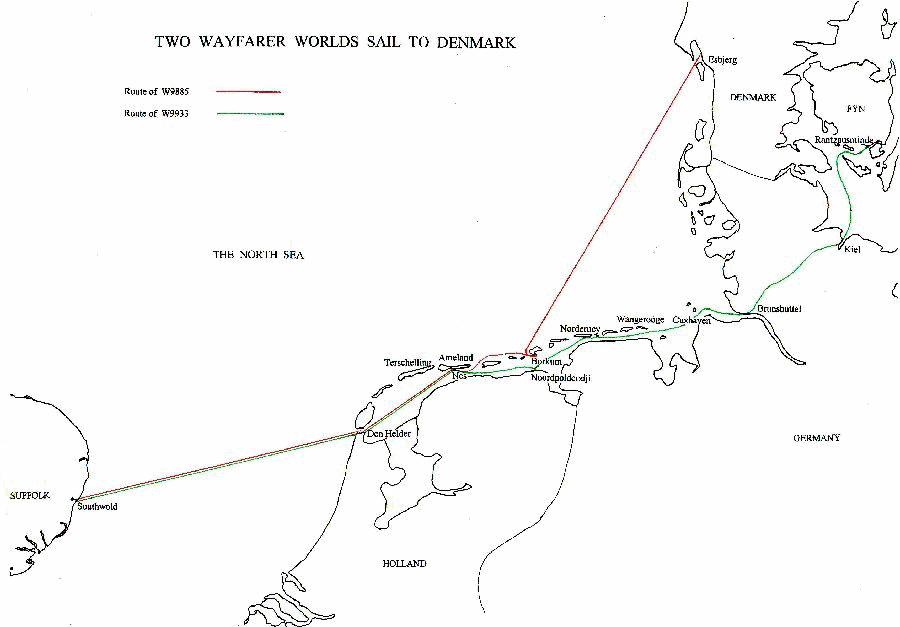
click here to see the
full-size version of this image
...Part 1 - Southwold
to Den Helder
“How about sailing our
Wayfarers across to Denmark to take part in the International
Wayfarer Rally at Rantzausminde?” Bob Harland had made this proposal
after I had suggested we attend the event in our latest World versions of this most
seaworthy and versatile of sailing dinghies. Rather than make the
crossing by the most direct route, we decided that sailing a series of
shorter legs, first to Den Helder, on the north-west tip of the
Netherlands, and then via the Friesian Islands to our destination,
would offer an easier and more interesting passage. Our original plan
was to set out from Southwold in Suffolk on the Saturday morning,
allowing us plenty of time to prepare for the trip. However, we had
needed to bring forward our departure to as early as possible the
previous evening, to enable us to reach Den Helder before a severe
gale, forecast for the Sunday evening
...Packing all the gear needed for
an open sea crossing into the new
interior layout of the Wayfarer World proved more time consuming than I
had anticipated, and it was 2230 by the time Cedric and I had finished
stowing everything aboard Spree Lady.
Bob and Clare had completed their packing earlier and had telephoned
the local Coastguard station to confirm our final passage plan and
request the latest weather forecast. This had given us westerly winds
up to Force 5, until a complex low pressure system with gale force
winds was expected, late on Sunday. With the excellent prospect of
getting to Den Helder before the gale arrived, we made the decision to
set sail.
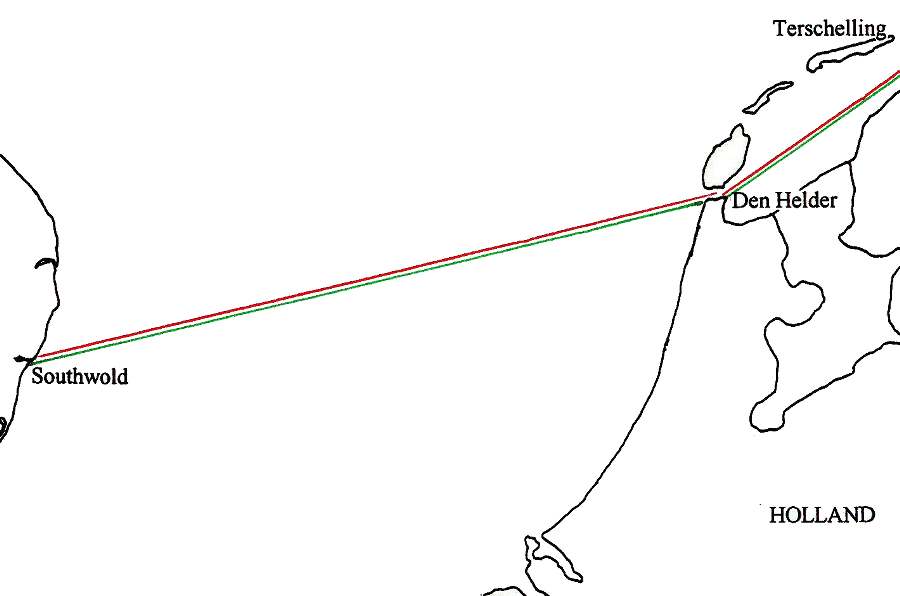
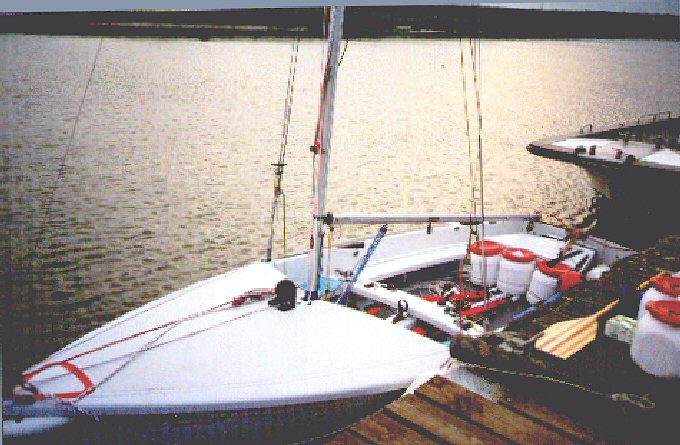
Spree Lady at Southwold Sailing Club
pontoon, being loaded with all the necessary gear for its North Sea
voyage.
The white bottles with red tops are water-tight containers, essential on an open boat.
All gear is secured to the boat with a length of line, so that it cannot become detached from the boat at any time.
The white bottles with red tops are water-tight containers, essential on an open boat.
All gear is secured to the boat with a length of line, so that it cannot become detached from the boat at any time.
We had an easy reach out of the
harbour with a F.3 offshore breeze and set a course of 074° to Den
Helder. An hour out, and away from the protection of the land, the wind
and sea state steadily increased. Bob and Clare, who had taken the
lead, took in a first reef for a more comfortable sail during the
night, and we immediately followed suit. The wind continued to build
and the rolling seas tipped the boat sufficiently to cause an
involuntary gybe. Bob pulled in a second reef, which helped us maintain
a more even pace, as our boat was more heavily laden with an outboard
and fuel. Unbeknownst to Cedric or myself though, this activity had
made Bob thoroughly sea sick. It was not until dawn that we noticed how
badly Bob had been affected by seasickness, so that he was unable to
assist Clare at all on the helm.
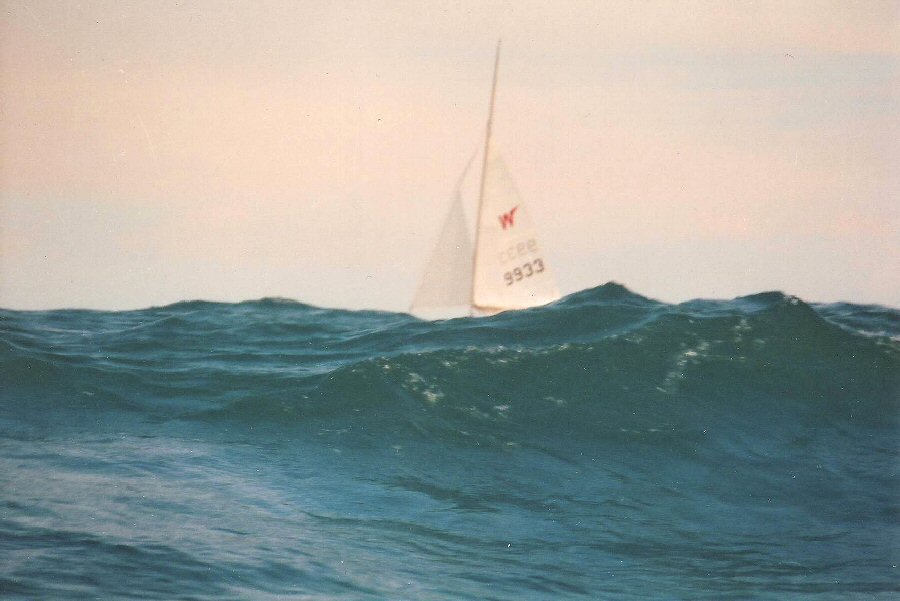
The
waves look more
ominous than they really were.
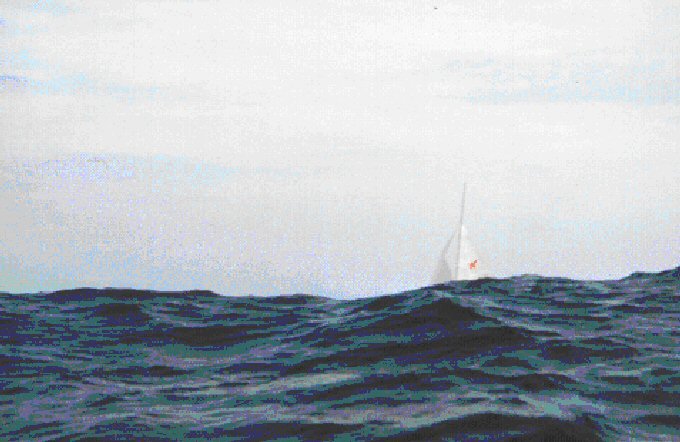
The
centreboard needs to be
almost fully raised to allow the boat to
ride over the wave,
rather than tripping over the board to cause a possible capsize.
rather than tripping over the board to cause a possible capsize.
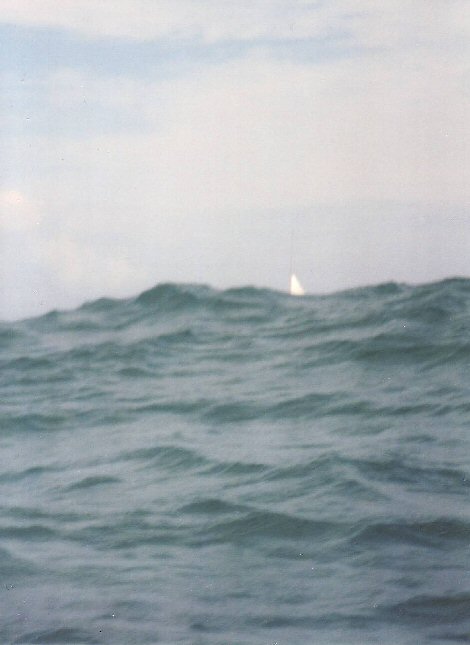
Both boats were equipped
with slab reefing systems that could be operated by the crew standing
in the centre of the boat by the mast. Reefing could then be carried
out whilst continuing to sail. The crew releases the
kicking strap (vang), whilst the helm releases the mainsheet
sufficiently to allow the crew to pull taut and cleat the clew reefing
line. The helm then adjusts the mainsheet to continue sailing the boat. The crew releases the main
halyard and pulls the sail luff down until the luff reefing cringle can be secured. (Different systems can
be used.) The kicking
strap is
re-tightened and the loose sail is tidied (with the shockcord ties
secured to the sail) only
as far as can be easily reached.
CLOTHING
Protection against the cold is
undoubtedly the most important consideration when exposed to the
elements, with little in the way of shelter. A three-layer system was
used to provide warmth and comfort. This consisted of Polartec
underwear to wick away body perspiration, a thermal mid layer with a
Polartec inner material and outer windproof layer, and an offshore
jacket and trousers to complete the outfit. Waterproof sailing boots
over two pairs of thermal socks kept our feet warm and dry. Gloves were
more of a problem, since they always got wet. However, Gill now market
waterproof sailing gloves which are ideal.
...By the early dawn we were
surfing along at over 6 knots on a near dead run in very strong
winds, and it seemed wise to take the main down to sail on the genoa
only. Bob and Clare who were just ahead of us did likewise, and
although our speed dropped to 5 knots, the sailing became a lot
more
comfortable. We sailed throughout the morning in heavy seas. Our new Wayfarer Worlds were proving every
bit as seaworthy as their predecessors, bucking and rearing over the
passing waves like an untamed colt, giving us confidence that they
could cope with all but the most extreme conditions.
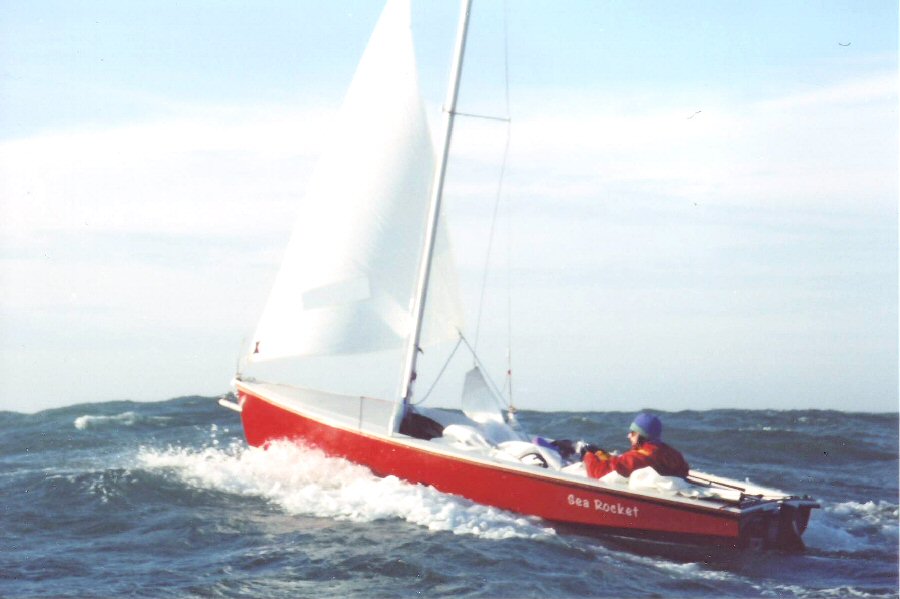
Clare
Harland on the helm, with Bob lying comfortably on the floor of the
other side of the boat.
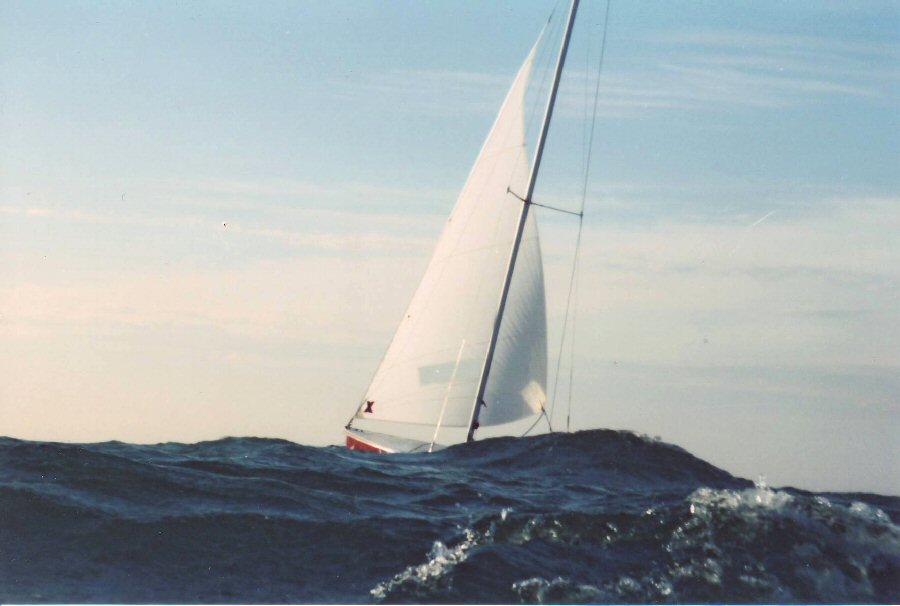 Sailing under
genoa only, reduces the chance of capsizing to the absolute minimum,
Sailing under
genoa only, reduces the chance of capsizing to the absolute minimum,even when sailing in the most extreme conditions.
When the occasional wave broke
showering us with spray as we neared its peak, any water that came
aboard disappeared from the self-draining cockpit in a matter of
seconds. I regretted not having a waterproof ‘throwaway’ camera, as I
always seemed to miss the best shots of the largest waves breaking. It
was inevitably too late by the time I had got my camera out of the
waterproof container.
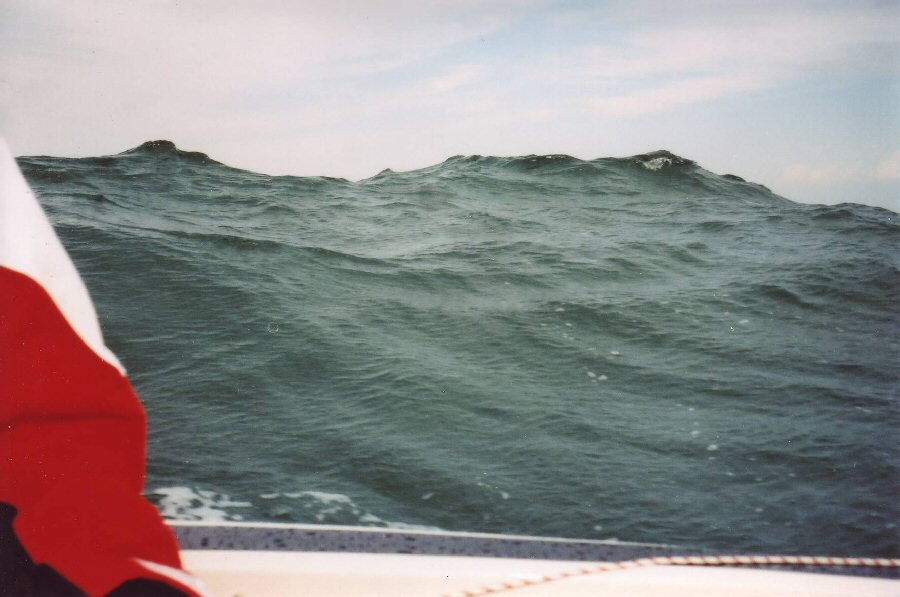
For
most of the day we were sailing through big seas,
even when the wind dropped sufficiently for us to put up our reefed mainsails again.
Sailing in these rough conditions demonstrated just how stable and seaworthy the Wayfarer is.
even when the wind dropped sufficiently for us to put up our reefed mainsails again.
Sailing in these rough conditions demonstrated just how stable and seaworthy the Wayfarer is.
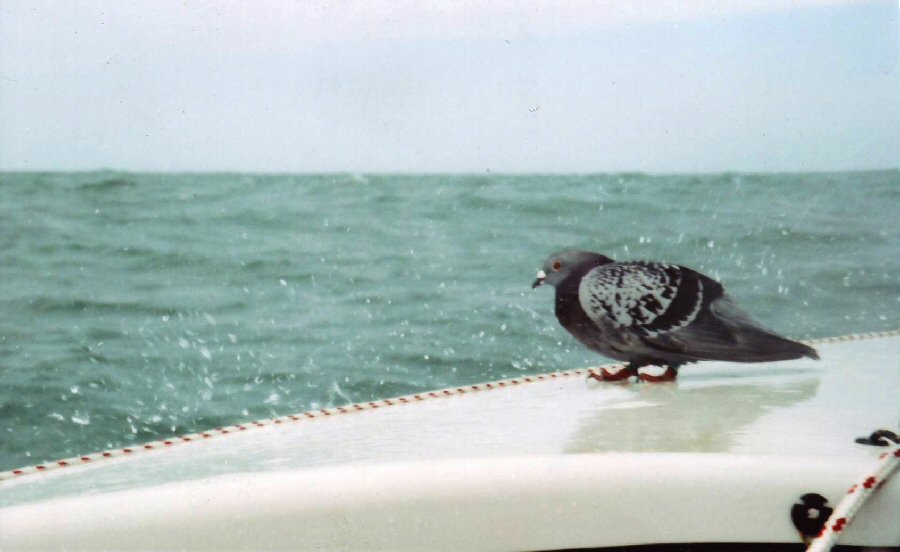
This
racing pigeon, clearly identifiable as such from the rings on its feet,
readily accepted being picked up and moved to a less precarious perch.
The sea state was considerably calmer after the storm had abated.
readily accepted being picked up and moved to a less precarious perch.
The sea state was considerably calmer after the storm had abated.
Just as we neared the halfway
point of our crossing, we were caught in a rainstorm. Strong winds can
be coped with in good spirits, but rain makes sailing particularly
unpleasant and somewhat depressing, especially when there is no
shelter. We were not the only ones to feel bedraggled, for just as the
rain was beginning to ease, a racing pigeon landed on the foredeck. It
looked totally exhausted, and allowed me to pick it up and put it under
the thwart, a somewhat less precarious position. A couple of hours
later, it had recovered sufficiently to object to me clearing up the
mess it had made in my new boat, and hopped up onto the mainsheet block
to fly off. I wished it well, but was not optimistic about its chances
of survival.
During the day the wind eased
occasionally, allowing us to raise our reefed mainsails. But a few
hours later, it would increase sufficiently to warrant taking them down
again. This activity certainly didn’t help Bob, whose seasickness was
obviously causing him real problems. I was amazed at how Clare had
managed to keep going for so long without falling asleep at the helm.
She had been continuously on the go, without any form of rest, for over
30 hours, and for much of that time she had been helming in extremely
demanding conditions. It is essential for the success of any extended
dinghy cruise for both crew to be experienced helms, but to cope on the
helm for so long was beyond anything that I could ever have managed.
Around this time Cedric also
succumbed to a bout of sea-sickness, but after a few hours of sleep and
then resting quietly for a while, he completed his recovery by helming,
as this helped him keep his focus on the horizon. I was certainly
thankful that he had been able to recover so quickly.
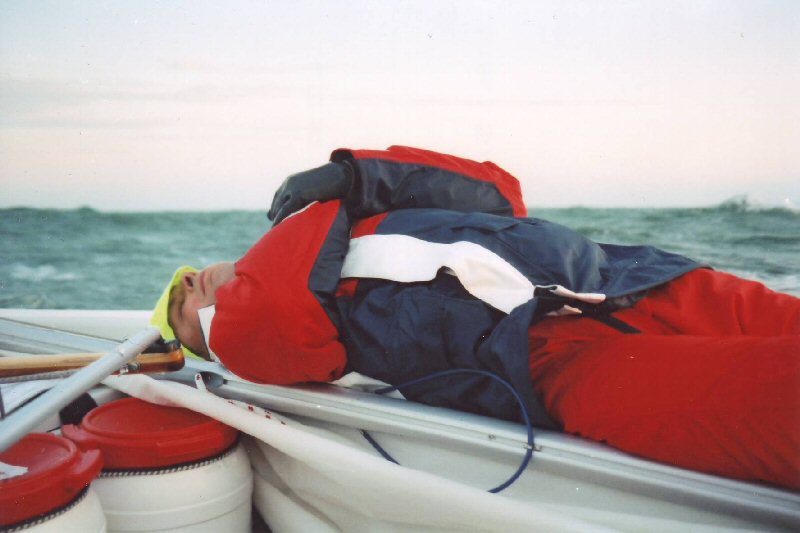
Cedric
asleep on the side seats and boom. This is a very exposed position in
which to rest,
even when secured by a safety harness.
even when secured by a safety harness.
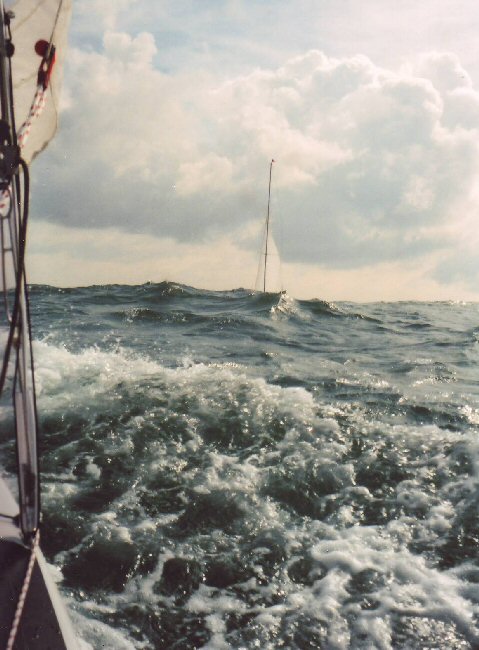
The Wayfarer World design is the more ideal version for
long distance cruising, since with the back buoyancy tank/storage
locker removed, it is possible to lie full length in the stern of the boat. I had not made the best use of this
space by choosing to take the removable rear locker, so there was nowhere we were able to lie
down comfortably in the bottom of the boat, which was really the only safe place to rest in the
rough conditions.
Bob and Clare, however, had chosen to
use some large dri-sacs they
had strapped down at the
back for rear storage. Bob was able to lie on these, giving him a far
safer and more comfortable
sleeping position.
...The wind dropped considerably
just before we approached the main shipping route off the Dutch coast -
just at the very time we needed to make good speed. Even though we put
up a full main and genoa for the first time since leaving Southwold, we
made only very slow progress. We entered the first (southbound) lane
just after 1900. There were a few vessels directly ahead, with another
approaching, so I suggested to Clare that I use my outboard to give her
a tow (Bob, being a sailing purist in the Frank Dye tradition, refuses
to carry one). We motored out of the path of the vessel coming from the
north before the wind picked up and we were able to re-hoist the sails.
I packed the outboard back into the boat again - a mistake as it turned
out, as it would have been far better to have left it on the transom
bracket ready for immediate use.
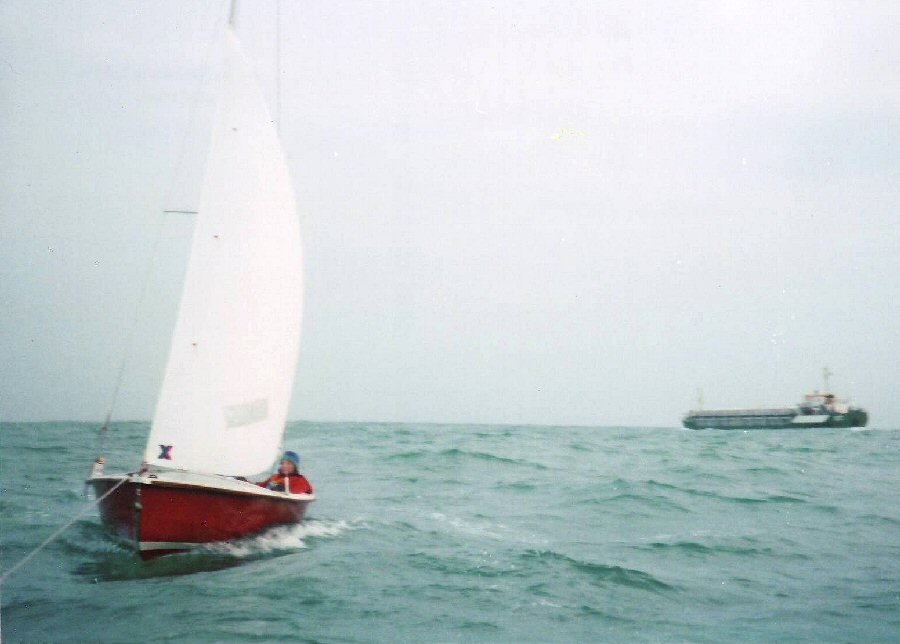
Towing
Sea Rocket through the first (southbound) shipping lane.
Initially there was a little wind to assist us, but then it dropped completely and we had to rely on the motor.
Initially there was a little wind to assist us, but then it dropped completely and we had to rely on the motor.
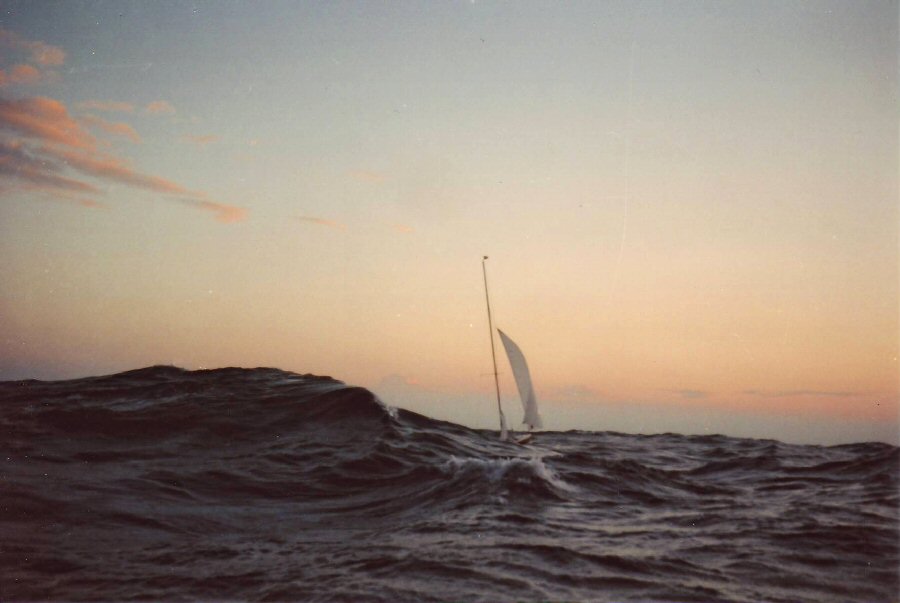
It
might well appear as though Sea Rocket is about to overwhelmed,
but in fact the wave is in the foreground, whilst Bob and Clare’s boat is a little distance away.
but in fact the wave is in the foreground, whilst Bob and Clare’s boat is a little distance away.
Now the wind was blowing
steadily, giving us good speed through the second (northbound) shipping
lane. This proved to be fortunate, since there were more ships using
it, and it was much easier to negotiate a safe passage across under
sail than it would have been towing Clare using the motor. With the
wind steadily increasing after we had exited the shipping lane, it
again became necessary to take down the main, and sail under genoa
only.
...Just after midnight, we were
able to pick up the distinctive flashing
sequence of the lighthouse at the entrance to Den Helder. In the bleak
darkness, without the moonlight of the previous night, it was a most
welcome sight on the horizon. Sea
Rocket’s masthead light had ceased to work the previous night,
and they disappeared from sight after stopping to hoist their mainsail.
We hove to to wait for them, our masthead light still clear and giving
our position. By the time they had passed us and we had raised our
main, Sea Rocket had
disappeared into the distance. Bob, having now recovered from his
seasickness, had taken over the helm to give Clare a well earned rest,
and had been keen to keep going and get his feet onto dry land!
Without their mast head light,
it was impossible to see Bob and Clare
anywhere ahead. I was disappointed to find we had become separated,
particularly as we needed to steer a more southerly course to
avoid the shallow water off the Noorderhaaks sandbank, which blocks the
direct route into Den Helder. I should have tried to raise Bob on the
radio, and it’s difficult to understand now why I didn’t do so. No
doubt tiredness was a major factor in my not appreciating that Bob
would automatically switch on his radio in the event of us losing
visual contact.
...Both boats carried hand held
VHF radios in waterproof plastic cases, and we had agreed on a channel for direct communication. I
had suggested prior to setting out, that we should try to conserve the radios' batteries for the
week-long trip by normally having the radios switched off. We agreed that whenever we needed to
communicate, we should wave the radio to indicate to the other boat the need to switch
their radio on. It seemed a reasonably practical system in theory, but it was not sufficiently
effective in practice, and most obviously not at night.
WATCHES
Cedric and I did not keep to any
particular watch schedule during the trip. Cedric found that helming when awake
made him less prone to seasickness. I therefore concentrated on the navigation and log
keeping, checking that all was in good order, taking photos, providing snacks, and resting whenever
possible. Long periods of sleep were not
possible, since lying down was never very comfortable! The person on the helm would simply wake
the other when too tired to carry on. Sailing a small boat long distances is entirely a team
effort.
...At around 0400, with the dawn
beginning to break, we approached the ominous sound of breaking waves
on the sandbank. I was reluctant to turn north to go round the top of
the island, and decided that it should be possible to get through the
area of lumpy sea directly ahead. It looked no worse than conditions I
had often experienced off Southwold. What I didn't take into account,
and never even imagined, was that the onshore winds would meet an
offshore breeze in this area of water, providing us with too little
drive to sail through at this point. Without the outboard readily
available to get us back to safety, the tide quickly took us into a
shallower, and much more treacherous area.
We were soon in amongst some
really horrendous breaking waves, which
would suddenly roar and thunder around us, crashing down with furious
pent-up energy. In my tired and anxious-to-get-ashore state, I had made
a monumental error of judgment by deciding to cross the shallow water.
It was a decision I now bitterly regretted. Somehow we managed to sail
round the worst of the breaking water, which was often down as much to
luck as it was trying to chart the areas to avoid, since thundering
waves would often suddenly erupt out of nowhere, in places where
previously there had been only extremely rough, but non-breaking
water.
On reaching an area where
there was a stronger
offshore breeze, I pulled in the sail and put down just a small amount
of plate. Fortunately I knew from my
canoeing experience that if we did get caught side-on to a breaking
wave, we needed to sit out and dig the gunwale into the crest, allowing
the boat to slide down the wave whilst it broke over
us; rather than presenting the hull to the wave, which would have
immediately capsized us, breaking
the mast in the shallow water, and putting us in an extremely dire
situation. Just when it
appeared we were going to be lucky enough to clear the area without
mishap, and escape to the safety
of deeper unbroken water immediately ahead of us, a wave suddenly
reared up with a
tremendous roar to starboard. Fortunately it was only half the size of
previous ones, and I just
managed to sit out as far as I could before it came crashing over us,
dashing the centreplate and
rudder against the sea bottom.
It was a heart stopping
experience, and a situation
I would never want to repeat. We were both totally drenched and the
boat had been filled with water, but
there had been just sufficient depth for the hull not to be dumped on
the hard sand below
with the considerable weight of water it now contained, and we suffered
no damage. It almost
seemed as though the sandbank, having spared us from the worst of the
breaking waves,
thought I needed a warning not to try the crossing again - a warning
that certainly wasn’t
necessary! Once in deeper water, I was able to put the outboard on the
transom bracket, enabling us to
motor through the Marsdiep channel towards Den Helder. Our thoughts
then turned to Bob
and Clare, wondering how they had fared in their approach to Den
Helder.
Bob and Clare had in fact been
behind us as we
approached the shallow water off the sandbank. I had assumed that as Sea Rocket had passed us, they
would be
somewhere in front. I had therefore only continuously scanned the
horizon ahead in the steadily increasing visibility of the dawn light.
It is obvious now that I should have made a complete
visual check of the horizon, as well as tried to make contact on the
radio. It is a classic example of
just how much tiredness can dull the mind.
Bob, having fully recovered
from his seasickness,
was undoubtedly in far better state to take a more rational approach to
the situation. He took a GPS fix, and
after plotting it on the chart, decided on the safer option of sailing
round the north end of
the sandbank, and through the Molengat channel into the Marsdiep,
crossing immediately over to the mainland to avoid being swept past Den
Helder by the strong flood tide.
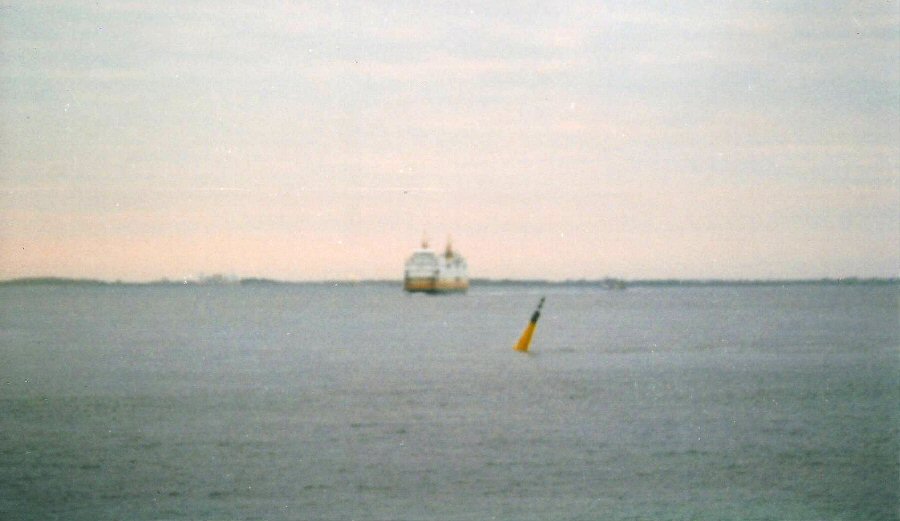
This
photo (taken the next evening) shows the strength of the tide
through the Marsdiep channel off Den Helder:
The North Cardinal mark is leaving a wake and being pushed over at that angle by the tide,
and the ferry is heading for a point to the right of the mark.
The North Cardinal mark is leaving a wake and being pushed over at that angle by the tide,
and the ferry is heading for a point to the right of the mark.
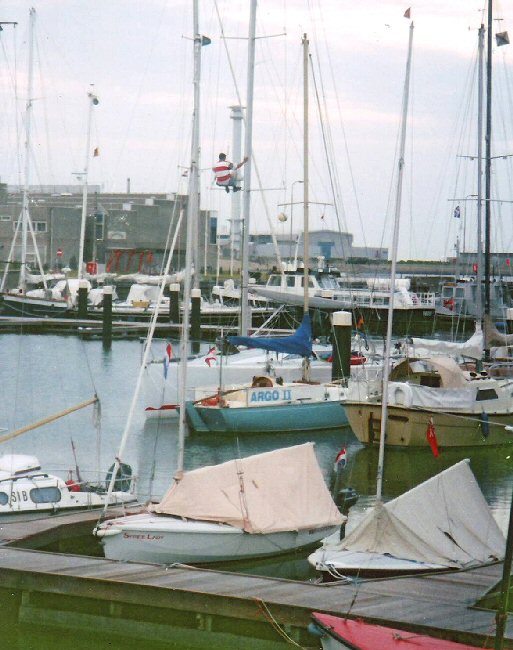
Moored up in
Den Helder. Behind us is the German racing yacht Hexe,
with a crew member halfway up the mast checking the rigging (see Part 2).
with a crew member halfway up the mast checking the rigging (see Part 2).
We used the outboard to motor
sail into the marina
at Den Helder, finally tying up to a mooring at 0525 on Sunday morning.
We were most concerned about Bob
and Clare however, and whilst still wondering whether to call the
Coastguard on
Channel 16, we saw the top of Bob and Clare's sail in the main channel
outside the harbour
entrance. We ran over to direct them into the marina, happy and
relieved that we had both
successfully made the crossing. We had completed the 120 NM. open sea
trip in just under 31 hours,
giving us an average speed of almost 4 knots.
Once we had found a suitable
place to tie up for an
overnight stop, we telephoned home to report that we had arrived
safely. Cedric asked his wife to
pass this information on to the local Gt. Yarmouth Coastguard station,
whom we had kept informed
about our passage plans. The Coastguard received her message of our
safe arrival
with some relief, since he followed it up in his broad Norfolk accent
with this timely advice,
“Just you tell ’em to stay right where they are, my dear. There’s a
gale a’blowing, and it’s coming their
way - the Yarmouth lifeboat’s been out three times already!” We had
obviously made the right decision to set off 14 hours earlier than
planned, to miss the gales, even though setting off in such a rush had
caused a certain lack of coordination in our sailing plans.
...We carried virtually all the essential equipment larger yachts would have on board for such a trip.
For
Navigation: Compass (on foredeck) plus hand bearing
type; large scale and more detailed inshore charts for route in waterproof
wallet; hand-held GPS; selected
sheets of safe havens and other
useful information from the Almanac; Breton plotter; dividers;
chinagraph and soft pencils; waterproof notebook.
For
Safety: Buoyancy aids - worn at all times, and
preferred to lifejackets for greater comfort and warmth; lifelines; crash hats; all
round white mast head light with 12v
sealed battery; radar reflector; hand-held VHF radio; flares; fog horn;
torch; survival bag; first aid
kit; assortment of spares and tools (pins, shackles, screws, drill, etc.);
anchors (x2), chain and 100m of
line; towline; fenders.
For
Propulsion: Mainsail and cut down 3/4 mainsail, both
with 1 deep reefing point and sail head buoyancy bag to prevent an inversion;
genoa; jib; spinnaker; Yamaha
Malta outboard plus fuel; oars and rowlocks; Canadian canoe paddle.
For
Comfort: Additional thermal and spare
clothing together with sleeping bag in waterproof dri-sacs;
tent; self-inflating mattress; Trangia cooker (meths stove)
and cooking utensils; food and snacks in waterproof plastic
containers; water and soft
drinks.
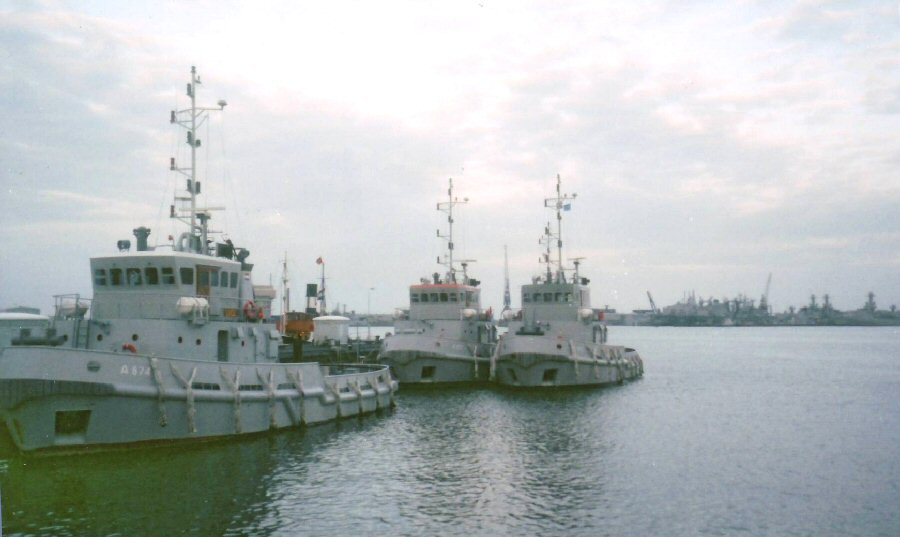
Den
Helder is the main base for the Dutch Naval Fleet. The large fleet of
all types of ships
appeared to take up a considerable part of the natural, and well sheltered harbour.
appeared to take up a considerable part of the natural, and well sheltered harbour.
LESSONS LEARNED
1. I would avoid leaving in quite
such haste on any future trip.
Although it was essential
to bring forward our time of departure, it did put
considerably greater pressure
on our preparation and packing. Taking time for a final and
more thorough check of
everything on the boat would have been time well spent and
made for a more seamanlike
departure. In the event, the experience gained from a
number of previous trips
meant that there was nothing that either boat needed and
didn’t have, and the only
gear failure was Bob and Clare’s masthead light, and a
tear in the luff of their
mainsail, which happened whilst Bob was taking out a reef.
2. We should have given some
thought as to how we
were going to sail together. Because we had sailed on a previous
North Sea crossing in company, we
made assumptions which
proved unwarranted. We ought to have agreed on having
a lead boat responsible
for navigation, with the other boat always following
close behind; using the
radio to communicate any changeover in the responsibility of
being the lead boat. Both
boats ought always to have sailed within sight of each
other, and preferably no
more than around 50m apart.
3. It would have been worth taking
enough
batteries to enable us to leave the radios switched on during the whole of the
crossing, or at the very least,
throughout the hours of
darkness.
4. I would never again risk crossing an
area of shallow,
rough water. Normally, whenever
a Wayfarer grounds, the water is shallow enough to let one step out and
push
the boat off. Breaking
water however, is just as dangerous to a Wayfarer as it is to
any other boat. Whilst I
am not normally a believer in the supernatural, it did seem
like someone up above
might well have been keeping a watchful eye on us, since we were
extremely fortunate to
come through our passage over the shallow waters off the
Den Helder sandbank
unscathed.
5. A lesson learnt from previous
North Sea
trips was to carry an outboard for crossing the shipping lanes. On any
future trip, I would secure it
permanently to the bracket
on the stern of the boat, ready for immediate use whenever
needed. It is of prime
importance on any open sea trip to minimise the possibility of a
capsize by reducing sail
early to suit the prevailing conditions. The outboard
should therefore be at no
greater risk of being submerged in sea water from a capsize by
being fixed on the back of
the boat, than it would if it were being carried inside the
boat.
...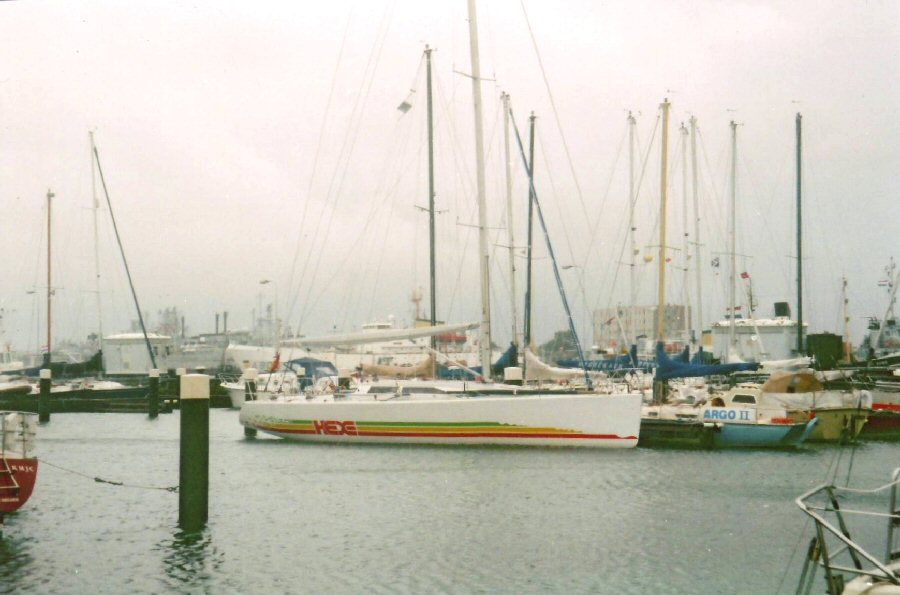
The German yacht Hexe, temporarily berthed in Den Helder marina for repairs.
Apart from the sailmaker to fix the sails, they had called in other specialists:
Divers checked the prop and rudder, and computer experts tried to fix the rig loading sensor on the mast.
We found ourselves in luck from
the misfortune (or rashness) of another yacht (above). A high tech racing yacht
on its way to Cowes Week to compete as part of the German team had
tried to sail/motor against the full force of the gale during the
previous night, and had been towed into Den Helder after putting out a
distress call. It looked as though they'd had an even wetter sail than
ourselves, with all their bedding and gear hung out on their enormous
boom to dry. Various specialists had immediately been called in to make
all the necessary repairs, one of which was a local sailmaker, as Hexe's enormous mainsail had been
badly ripped when the crew had struggled to get it down in the gale
force winds. The sailmaker willingly picked up Bob's mainsail at the
same time, and brought it back some hours later, spending time
explaining what he had done, and giving us general advice about the
sails. It was apparent that he was somewhat contemptuous of the yacht
skipper’s poor seamanship, and had considerably more regard and
interest in our adventurous trip.
Seafaring folk seem to fall
into two categories when told that you sail
a small boat across the open sea. They either respect and admire your
seamanship and offer you every assistance, or they think you are just
totally mad and reckless with no regard for your own (or others) safety
and treat you with disdain. The sailmaker collecting the racing yacht's
sails fortunately fell into the first category.
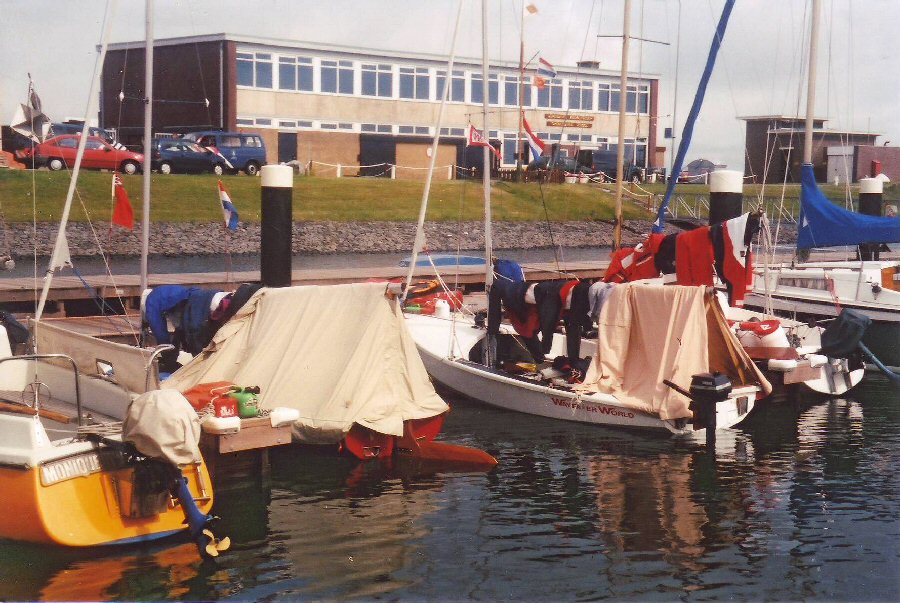
Drying out in Den Helder. Our sailing gear and equipment covered much of the main
walkway, the two finger pontoons, and the yachts moored adjacent to us!
As the day was generally fine
and sunny, I spent some time sorting out all our gear, spreading it out
along the walkway, finger jetty, and adjacent boats. Other yachtsmen
walking by, generally expressed their amazement that so much equipment
could be stored in such a small boat. That done, we had a relaxing meal
in the marina restaurant, and settled down for another early night.
While the gale had blown through the previous night without bothering
us too much, the next night was far less pleasant. Not only were there
very strong winds, but also thunder and lightning, with rain so heavy
that it penetrated the fabric of the tent. The problem was quickly
resolved by tearing open a plastic survival bag I'd been carrying about
for years without using, and spreading it over our sleeping bags to
keep us dry.
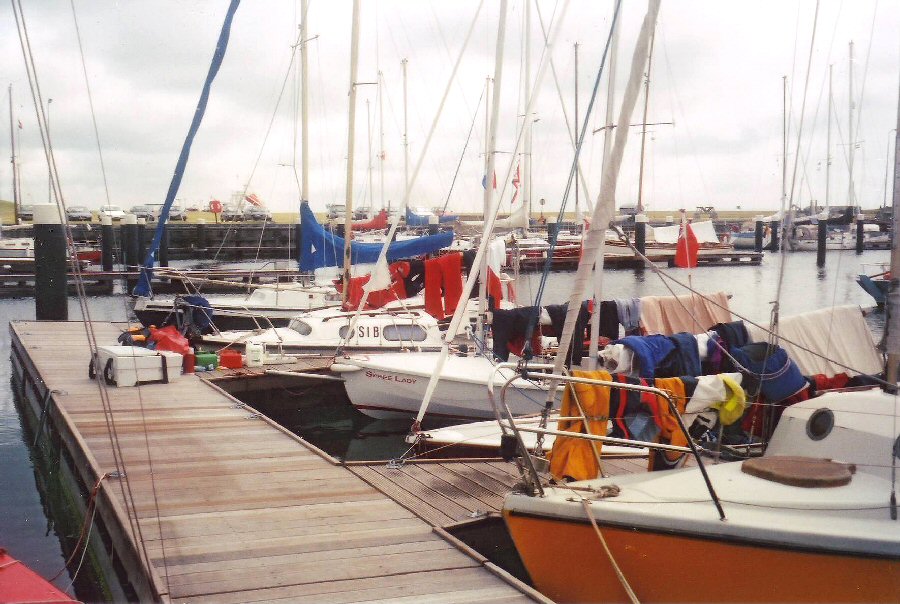
Another view of all our gear taking up any useful space. The back locker rather blocks the walkway - fortunately the only ones who used this part of the pontoon were those who came to see how two small boats could carry so much equipment!
...